Interpretation of the Judiciary
VerifiedAdded on 2023/04/21
|11
|3193
|131
AI Summary
This paper evaluates diverse opinions on the interpretation of the judiciary, current policy frameworks, and defense towards statutes. It also discusses the impact of the Human Rights Act on UK laws and the role of the courts in interpreting legislation.
Contribute Materials
Your contribution can guide someone’s learning journey. Share your
documents today.
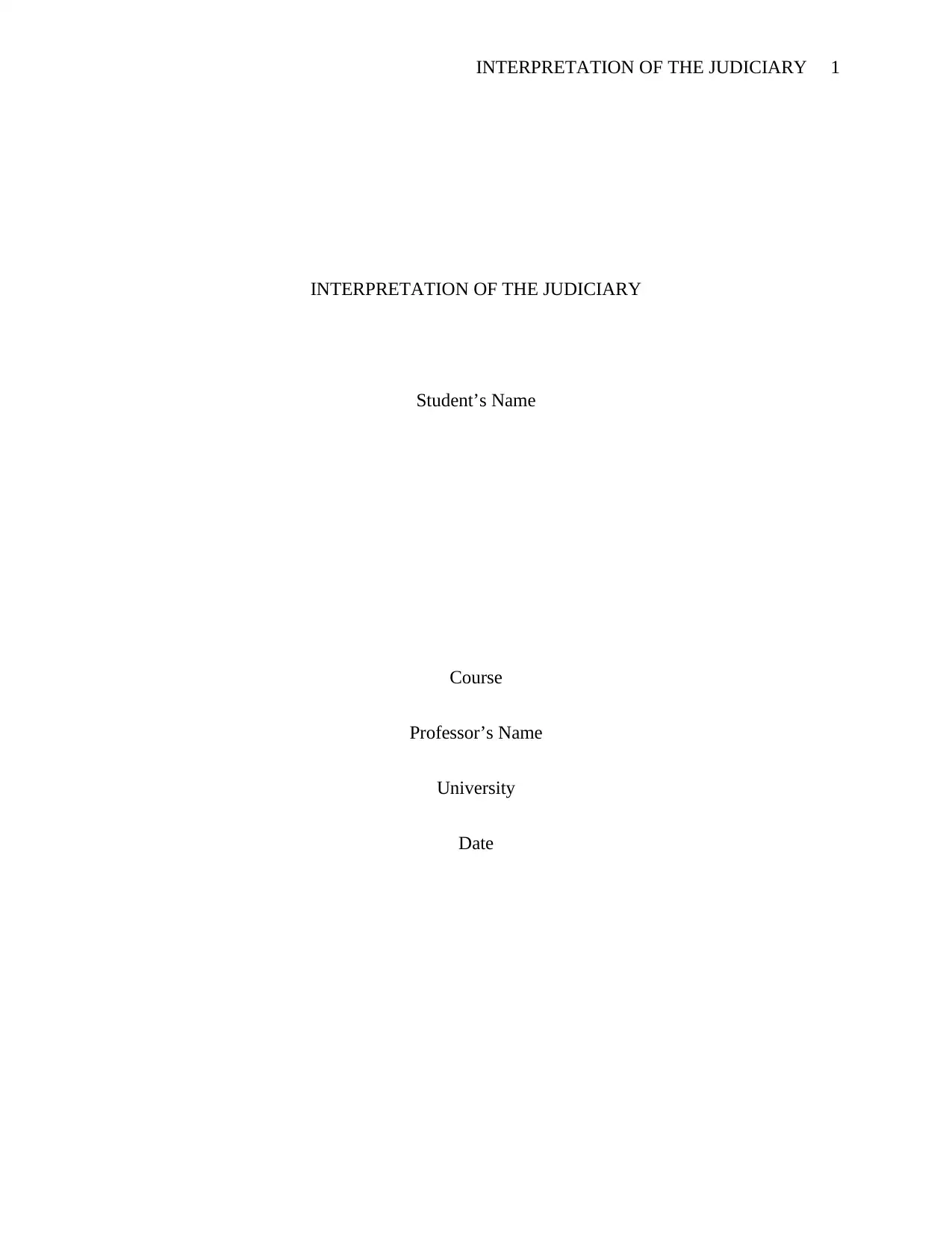
INTERPRETATION OF THE JUDICIARY 1
INTERPRETATION OF THE JUDICIARY
Student’s Name
Course
Professor’s Name
University
Date
INTERPRETATION OF THE JUDICIARY
Student’s Name
Course
Professor’s Name
University
Date
Secure Best Marks with AI Grader
Need help grading? Try our AI Grader for instant feedback on your assignments.
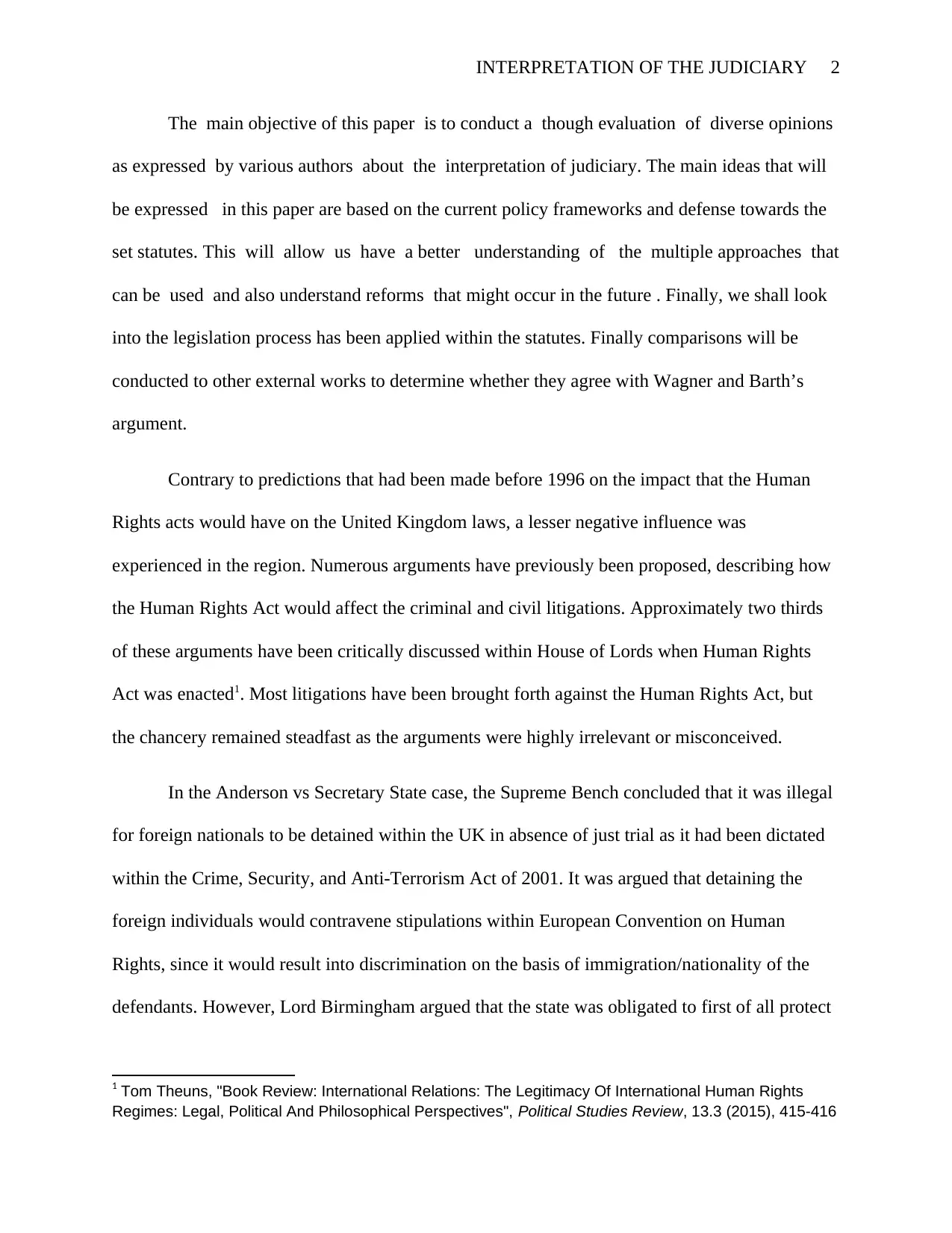
INTERPRETATION OF THE JUDICIARY 2
The main objective of this paper is to conduct a though evaluation of diverse opinions
as expressed by various authors about the interpretation of judiciary. The main ideas that will
be expressed in this paper are based on the current policy frameworks and defense towards the
set statutes. This will allow us have a better understanding of the multiple approaches that
can be used and also understand reforms that might occur in the future . Finally, we shall look
into the legislation process has been applied within the statutes. Finally comparisons will be
conducted to other external works to determine whether they agree with Wagner and Barth’s
argument.
Contrary to predictions that had been made before 1996 on the impact that the Human
Rights acts would have on the United Kingdom laws, a lesser negative influence was
experienced in the region. Numerous arguments have previously been proposed, describing how
the Human Rights Act would affect the criminal and civil litigations. Approximately two thirds
of these arguments have been critically discussed within House of Lords when Human Rights
Act was enacted1. Most litigations have been brought forth against the Human Rights Act, but
the chancery remained steadfast as the arguments were highly irrelevant or misconceived.
In the Anderson vs Secretary State case, the Supreme Bench concluded that it was illegal
for foreign nationals to be detained within the UK in absence of just trial as it had been dictated
within the Crime, Security, and Anti-Terrorism Act of 2001. It was argued that detaining the
foreign individuals would contravene stipulations within European Convention on Human
Rights, since it would result into discrimination on the basis of immigration/nationality of the
defendants. However, Lord Birmingham argued that the state was obligated to first of all protect
1 Tom Theuns, "Book Review: International Relations: The Legitimacy Of International Human Rights
Regimes: Legal, Political And Philosophical Perspectives", Political Studies Review, 13.3 (2015), 415-416
The main objective of this paper is to conduct a though evaluation of diverse opinions
as expressed by various authors about the interpretation of judiciary. The main ideas that will
be expressed in this paper are based on the current policy frameworks and defense towards the
set statutes. This will allow us have a better understanding of the multiple approaches that
can be used and also understand reforms that might occur in the future . Finally, we shall look
into the legislation process has been applied within the statutes. Finally comparisons will be
conducted to other external works to determine whether they agree with Wagner and Barth’s
argument.
Contrary to predictions that had been made before 1996 on the impact that the Human
Rights acts would have on the United Kingdom laws, a lesser negative influence was
experienced in the region. Numerous arguments have previously been proposed, describing how
the Human Rights Act would affect the criminal and civil litigations. Approximately two thirds
of these arguments have been critically discussed within House of Lords when Human Rights
Act was enacted1. Most litigations have been brought forth against the Human Rights Act, but
the chancery remained steadfast as the arguments were highly irrelevant or misconceived.
In the Anderson vs Secretary State case, the Supreme Bench concluded that it was illegal
for foreign nationals to be detained within the UK in absence of just trial as it had been dictated
within the Crime, Security, and Anti-Terrorism Act of 2001. It was argued that detaining the
foreign individuals would contravene stipulations within European Convention on Human
Rights, since it would result into discrimination on the basis of immigration/nationality of the
defendants. However, Lord Birmingham argued that the state was obligated to first of all protect
1 Tom Theuns, "Book Review: International Relations: The Legitimacy Of International Human Rights
Regimes: Legal, Political And Philosophical Perspectives", Political Studies Review, 13.3 (2015), 415-416

INTERPRETATION OF THE JUDICIARY 3
the security of its citizens2. He argued that this would be achieved by declaring the existence of
an emergency that had the potential to hamper the continuity of the country’s well-being.
However, the court lacks the appropriate powers to strike out a legislation that is defined under
the Human Rights Act3. Hence, this forced the defendants in this particular case to remain in
court indefinitely until a certain particular time when it would be proved that they are innocent.
The government was, therefore, allowed enough time to establish appropriate public safety
strategies was upheld through enacting the Control Orders for the Mitigation of Terrorism Act
2005. The new system is still being reviewed by the courts to-date.
A vital point expressed by Wagner and Barth in the entire article revolved around how
inconsistent the decisions made by the judiciary are regarding section 3 of the Human Rights
Act. However he eventually concludes that , while the courts appeared to have a more
activist approach , this has reduced over the years. The authors use the Ballinger v Ballinger
case where a fundamental change in the conventional ways of marriage were perceived as a
matter that needed to be discussed in parliament. While there are exceptions, the court do not
entirely go too far beyond the set statutes. Gerards supports the idea concluding that it is
infect possible to define what might be termed as the limiting factor while interpreting the
obligations of the courts under S.3 of the HRA.4
Despite the common ground by most of these academics , there are multiple
disagreements over their point of view on the approach used by courts in earlier cases such
2 Richard Bellamy, Political Constitutionalism And The Human Rights Act (Oxford University Press and
New York University School of Law, 2011), pp. 87-109.
3 Tom R Hickman, Constitutionalism In The United Kingdom, 2004.
4 J. H Gerards and J. W. A Fleuren, Implementation Of The European Convention On Human Rights And
Of The Judgments Of The Ecthr In National Case-Law (Cambridge: Intersentia, 2014).
the security of its citizens2. He argued that this would be achieved by declaring the existence of
an emergency that had the potential to hamper the continuity of the country’s well-being.
However, the court lacks the appropriate powers to strike out a legislation that is defined under
the Human Rights Act3. Hence, this forced the defendants in this particular case to remain in
court indefinitely until a certain particular time when it would be proved that they are innocent.
The government was, therefore, allowed enough time to establish appropriate public safety
strategies was upheld through enacting the Control Orders for the Mitigation of Terrorism Act
2005. The new system is still being reviewed by the courts to-date.
A vital point expressed by Wagner and Barth in the entire article revolved around how
inconsistent the decisions made by the judiciary are regarding section 3 of the Human Rights
Act. However he eventually concludes that , while the courts appeared to have a more
activist approach , this has reduced over the years. The authors use the Ballinger v Ballinger
case where a fundamental change in the conventional ways of marriage were perceived as a
matter that needed to be discussed in parliament. While there are exceptions, the court do not
entirely go too far beyond the set statutes. Gerards supports the idea concluding that it is
infect possible to define what might be termed as the limiting factor while interpreting the
obligations of the courts under S.3 of the HRA.4
Despite the common ground by most of these academics , there are multiple
disagreements over their point of view on the approach used by courts in earlier cases such
2 Richard Bellamy, Political Constitutionalism And The Human Rights Act (Oxford University Press and
New York University School of Law, 2011), pp. 87-109.
3 Tom R Hickman, Constitutionalism In The United Kingdom, 2004.
4 J. H Gerards and J. W. A Fleuren, Implementation Of The European Convention On Human Rights And
Of The Judgments Of The Ecthr In National Case-Law (Cambridge: Intersentia, 2014).
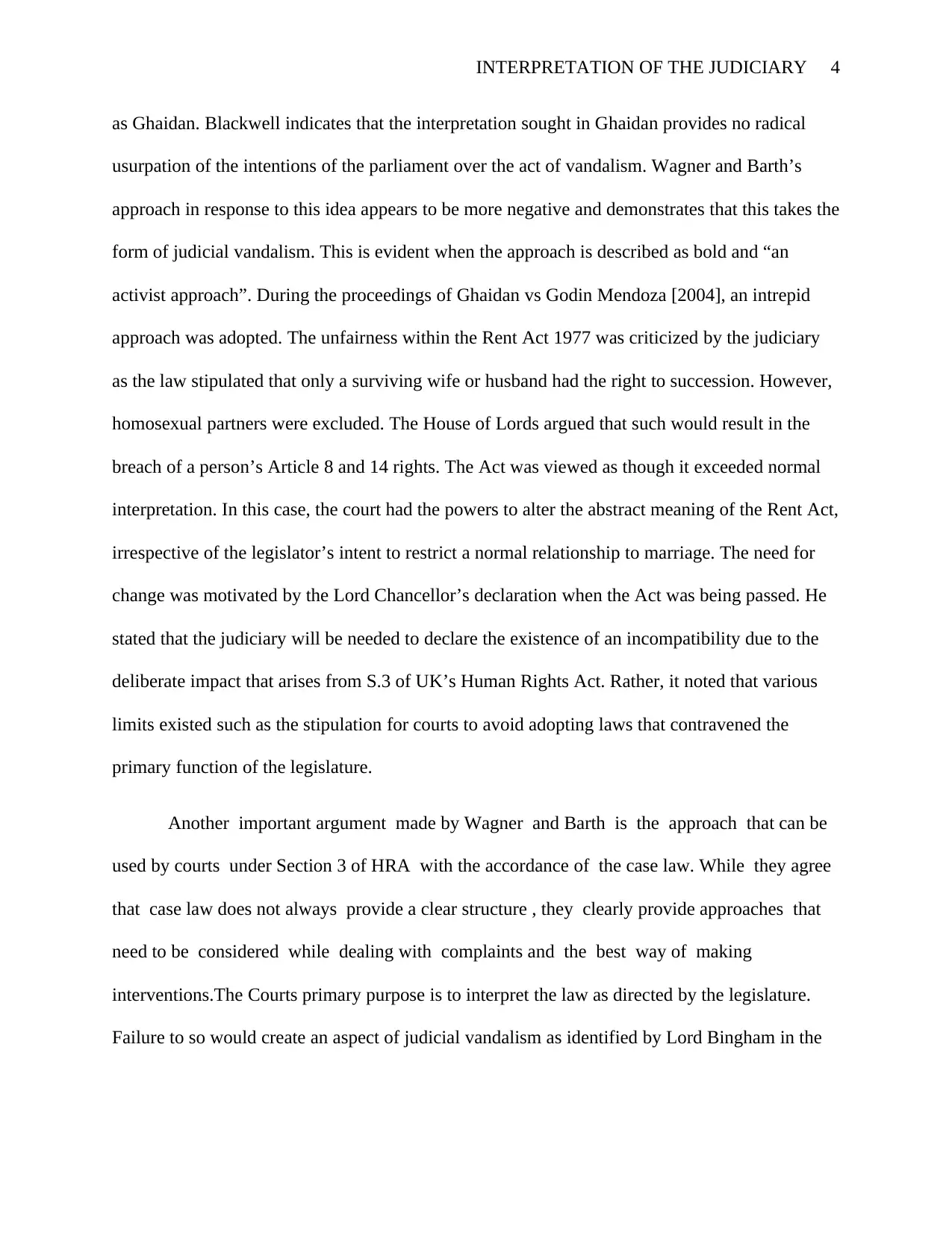
INTERPRETATION OF THE JUDICIARY 4
as Ghaidan. Blackwell indicates that the interpretation sought in Ghaidan provides no radical
usurpation of the intentions of the parliament over the act of vandalism. Wagner and Barth’s
approach in response to this idea appears to be more negative and demonstrates that this takes the
form of judicial vandalism. This is evident when the approach is described as bold and “an
activist approach”. During the proceedings of Ghaidan vs Godin Mendoza [2004], an intrepid
approach was adopted. The unfairness within the Rent Act 1977 was criticized by the judiciary
as the law stipulated that only a surviving wife or husband had the right to succession. However,
homosexual partners were excluded. The House of Lords argued that such would result in the
breach of a person’s Article 8 and 14 rights. The Act was viewed as though it exceeded normal
interpretation. In this case, the court had the powers to alter the abstract meaning of the Rent Act,
irrespective of the legislator’s intent to restrict a normal relationship to marriage. The need for
change was motivated by the Lord Chancellor’s declaration when the Act was being passed. He
stated that the judiciary will be needed to declare the existence of an incompatibility due to the
deliberate impact that arises from S.3 of UK’s Human Rights Act. Rather, it noted that various
limits existed such as the stipulation for courts to avoid adopting laws that contravened the
primary function of the legislature.
Another important argument made by Wagner and Barth is the approach that can be
used by courts under Section 3 of HRA with the accordance of the case law. While they agree
that case law does not always provide a clear structure , they clearly provide approaches that
need to be considered while dealing with complaints and the best way of making
interventions.The Courts primary purpose is to interpret the law as directed by the legislature.
Failure to so would create an aspect of judicial vandalism as identified by Lord Bingham in the
as Ghaidan. Blackwell indicates that the interpretation sought in Ghaidan provides no radical
usurpation of the intentions of the parliament over the act of vandalism. Wagner and Barth’s
approach in response to this idea appears to be more negative and demonstrates that this takes the
form of judicial vandalism. This is evident when the approach is described as bold and “an
activist approach”. During the proceedings of Ghaidan vs Godin Mendoza [2004], an intrepid
approach was adopted. The unfairness within the Rent Act 1977 was criticized by the judiciary
as the law stipulated that only a surviving wife or husband had the right to succession. However,
homosexual partners were excluded. The House of Lords argued that such would result in the
breach of a person’s Article 8 and 14 rights. The Act was viewed as though it exceeded normal
interpretation. In this case, the court had the powers to alter the abstract meaning of the Rent Act,
irrespective of the legislator’s intent to restrict a normal relationship to marriage. The need for
change was motivated by the Lord Chancellor’s declaration when the Act was being passed. He
stated that the judiciary will be needed to declare the existence of an incompatibility due to the
deliberate impact that arises from S.3 of UK’s Human Rights Act. Rather, it noted that various
limits existed such as the stipulation for courts to avoid adopting laws that contravened the
primary function of the legislature.
Another important argument made by Wagner and Barth is the approach that can be
used by courts under Section 3 of HRA with the accordance of the case law. While they agree
that case law does not always provide a clear structure , they clearly provide approaches that
need to be considered while dealing with complaints and the best way of making
interventions.The Courts primary purpose is to interpret the law as directed by the legislature.
Failure to so would create an aspect of judicial vandalism as identified by Lord Bingham in the
Secure Best Marks with AI Grader
Need help grading? Try our AI Grader for instant feedback on your assignments.
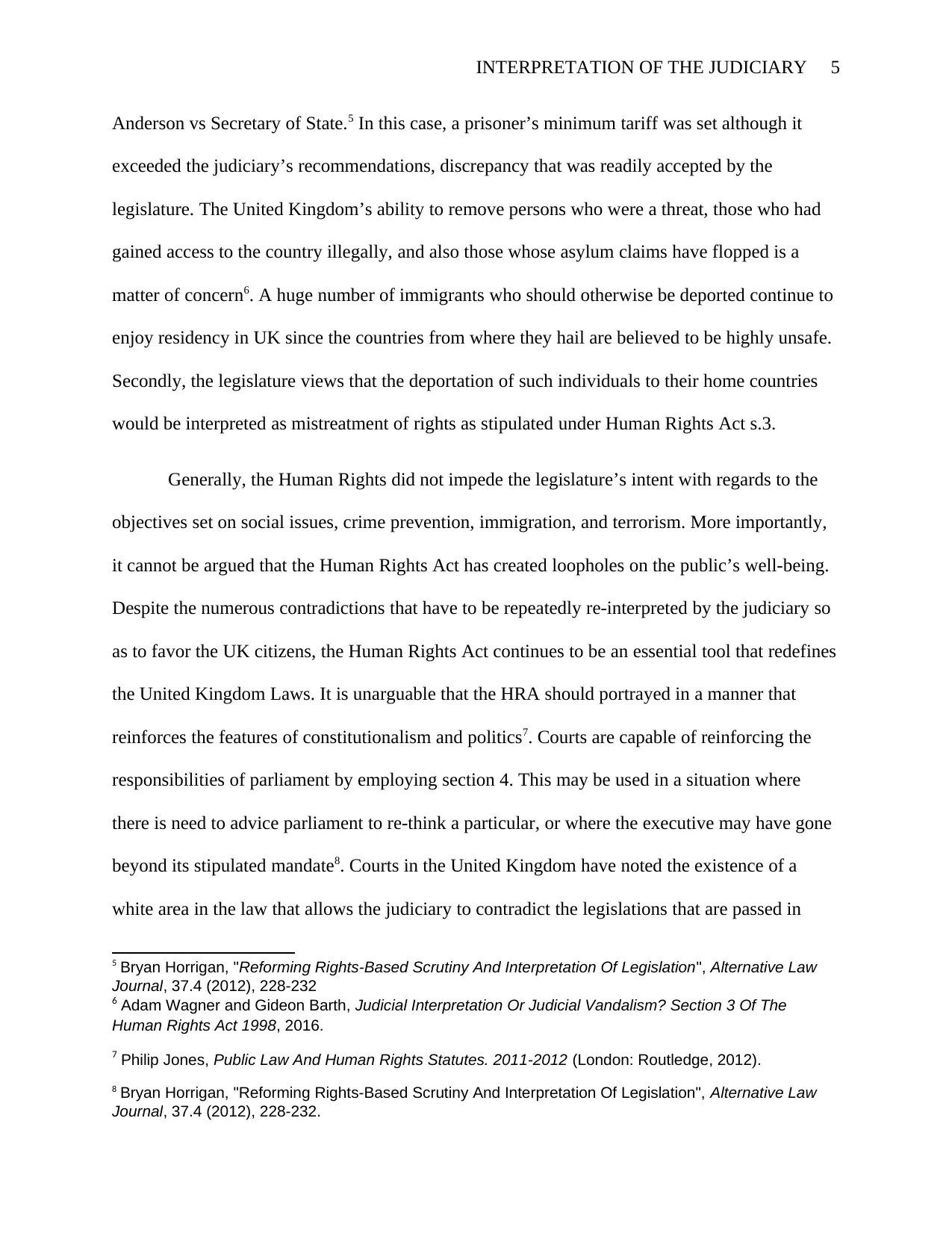
INTERPRETATION OF THE JUDICIARY 5
Anderson vs Secretary of State.5 In this case, a prisoner’s minimum tariff was set although it
exceeded the judiciary’s recommendations, discrepancy that was readily accepted by the
legislature. The United Kingdom’s ability to remove persons who were a threat, those who had
gained access to the country illegally, and also those whose asylum claims have flopped is a
matter of concern6. A huge number of immigrants who should otherwise be deported continue to
enjoy residency in UK since the countries from where they hail are believed to be highly unsafe.
Secondly, the legislature views that the deportation of such individuals to their home countries
would be interpreted as mistreatment of rights as stipulated under Human Rights Act s.3.
Generally, the Human Rights did not impede the legislature’s intent with regards to the
objectives set on social issues, crime prevention, immigration, and terrorism. More importantly,
it cannot be argued that the Human Rights Act has created loopholes on the public’s well-being.
Despite the numerous contradictions that have to be repeatedly re-interpreted by the judiciary so
as to favor the UK citizens, the Human Rights Act continues to be an essential tool that redefines
the United Kingdom Laws. It is unarguable that the HRA should portrayed in a manner that
reinforces the features of constitutionalism and politics7. Courts are capable of reinforcing the
responsibilities of parliament by employing section 4. This may be used in a situation where
there is need to advice parliament to re-think a particular, or where the executive may have gone
beyond its stipulated mandate8. Courts in the United Kingdom have noted the existence of a
white area in the law that allows the judiciary to contradict the legislations that are passed in
5 Bryan Horrigan, "Reforming Rights-Based Scrutiny And Interpretation Of Legislation", Alternative Law
Journal, 37.4 (2012), 228-232
6 Adam Wagner and Gideon Barth, Judicial Interpretation Or Judicial Vandalism? Section 3 Of The
Human Rights Act 1998, 2016.
7 Philip Jones, Public Law And Human Rights Statutes. 2011-2012 (London: Routledge, 2012).
8 Bryan Horrigan, "Reforming Rights-Based Scrutiny And Interpretation Of Legislation", Alternative Law
Journal, 37.4 (2012), 228-232.
Anderson vs Secretary of State.5 In this case, a prisoner’s minimum tariff was set although it
exceeded the judiciary’s recommendations, discrepancy that was readily accepted by the
legislature. The United Kingdom’s ability to remove persons who were a threat, those who had
gained access to the country illegally, and also those whose asylum claims have flopped is a
matter of concern6. A huge number of immigrants who should otherwise be deported continue to
enjoy residency in UK since the countries from where they hail are believed to be highly unsafe.
Secondly, the legislature views that the deportation of such individuals to their home countries
would be interpreted as mistreatment of rights as stipulated under Human Rights Act s.3.
Generally, the Human Rights did not impede the legislature’s intent with regards to the
objectives set on social issues, crime prevention, immigration, and terrorism. More importantly,
it cannot be argued that the Human Rights Act has created loopholes on the public’s well-being.
Despite the numerous contradictions that have to be repeatedly re-interpreted by the judiciary so
as to favor the UK citizens, the Human Rights Act continues to be an essential tool that redefines
the United Kingdom Laws. It is unarguable that the HRA should portrayed in a manner that
reinforces the features of constitutionalism and politics7. Courts are capable of reinforcing the
responsibilities of parliament by employing section 4. This may be used in a situation where
there is need to advice parliament to re-think a particular, or where the executive may have gone
beyond its stipulated mandate8. Courts in the United Kingdom have noted the existence of a
white area in the law that allows the judiciary to contradict the legislations that are passed in
5 Bryan Horrigan, "Reforming Rights-Based Scrutiny And Interpretation Of Legislation", Alternative Law
Journal, 37.4 (2012), 228-232
6 Adam Wagner and Gideon Barth, Judicial Interpretation Or Judicial Vandalism? Section 3 Of The
Human Rights Act 1998, 2016.
7 Philip Jones, Public Law And Human Rights Statutes. 2011-2012 (London: Routledge, 2012).
8 Bryan Horrigan, "Reforming Rights-Based Scrutiny And Interpretation Of Legislation", Alternative Law
Journal, 37.4 (2012), 228-232.
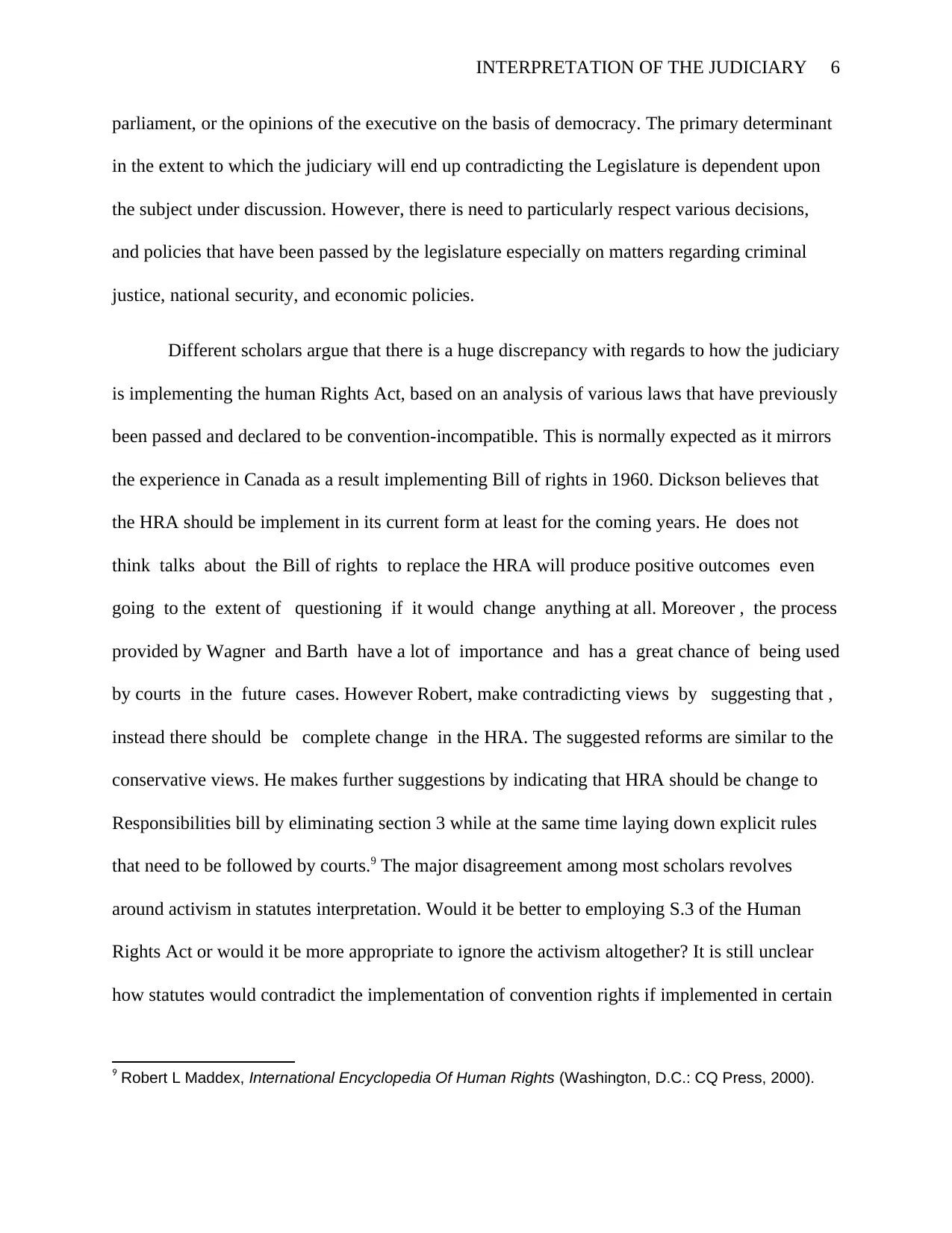
INTERPRETATION OF THE JUDICIARY 6
parliament, or the opinions of the executive on the basis of democracy. The primary determinant
in the extent to which the judiciary will end up contradicting the Legislature is dependent upon
the subject under discussion. However, there is need to particularly respect various decisions,
and policies that have been passed by the legislature especially on matters regarding criminal
justice, national security, and economic policies.
Different scholars argue that there is a huge discrepancy with regards to how the judiciary
is implementing the human Rights Act, based on an analysis of various laws that have previously
been passed and declared to be convention-incompatible. This is normally expected as it mirrors
the experience in Canada as a result implementing Bill of rights in 1960. Dickson believes that
the HRA should be implement in its current form at least for the coming years. He does not
think talks about the Bill of rights to replace the HRA will produce positive outcomes even
going to the extent of questioning if it would change anything at all. Moreover , the process
provided by Wagner and Barth have a lot of importance and has a great chance of being used
by courts in the future cases. However Robert, make contradicting views by suggesting that ,
instead there should be complete change in the HRA. The suggested reforms are similar to the
conservative views. He makes further suggestions by indicating that HRA should be change to
Responsibilities bill by eliminating section 3 while at the same time laying down explicit rules
that need to be followed by courts.9 The major disagreement among most scholars revolves
around activism in statutes interpretation. Would it be better to employing S.3 of the Human
Rights Act or would it be more appropriate to ignore the activism altogether? It is still unclear
how statutes would contradict the implementation of convention rights if implemented in certain
9 Robert L Maddex, International Encyclopedia Of Human Rights (Washington, D.C.: CQ Press, 2000).
parliament, or the opinions of the executive on the basis of democracy. The primary determinant
in the extent to which the judiciary will end up contradicting the Legislature is dependent upon
the subject under discussion. However, there is need to particularly respect various decisions,
and policies that have been passed by the legislature especially on matters regarding criminal
justice, national security, and economic policies.
Different scholars argue that there is a huge discrepancy with regards to how the judiciary
is implementing the human Rights Act, based on an analysis of various laws that have previously
been passed and declared to be convention-incompatible. This is normally expected as it mirrors
the experience in Canada as a result implementing Bill of rights in 1960. Dickson believes that
the HRA should be implement in its current form at least for the coming years. He does not
think talks about the Bill of rights to replace the HRA will produce positive outcomes even
going to the extent of questioning if it would change anything at all. Moreover , the process
provided by Wagner and Barth have a lot of importance and has a great chance of being used
by courts in the future cases. However Robert, make contradicting views by suggesting that ,
instead there should be complete change in the HRA. The suggested reforms are similar to the
conservative views. He makes further suggestions by indicating that HRA should be change to
Responsibilities bill by eliminating section 3 while at the same time laying down explicit rules
that need to be followed by courts.9 The major disagreement among most scholars revolves
around activism in statutes interpretation. Would it be better to employing S.3 of the Human
Rights Act or would it be more appropriate to ignore the activism altogether? It is still unclear
how statutes would contradict the implementation of convention rights if implemented in certain
9 Robert L Maddex, International Encyclopedia Of Human Rights (Washington, D.C.: CQ Press, 2000).
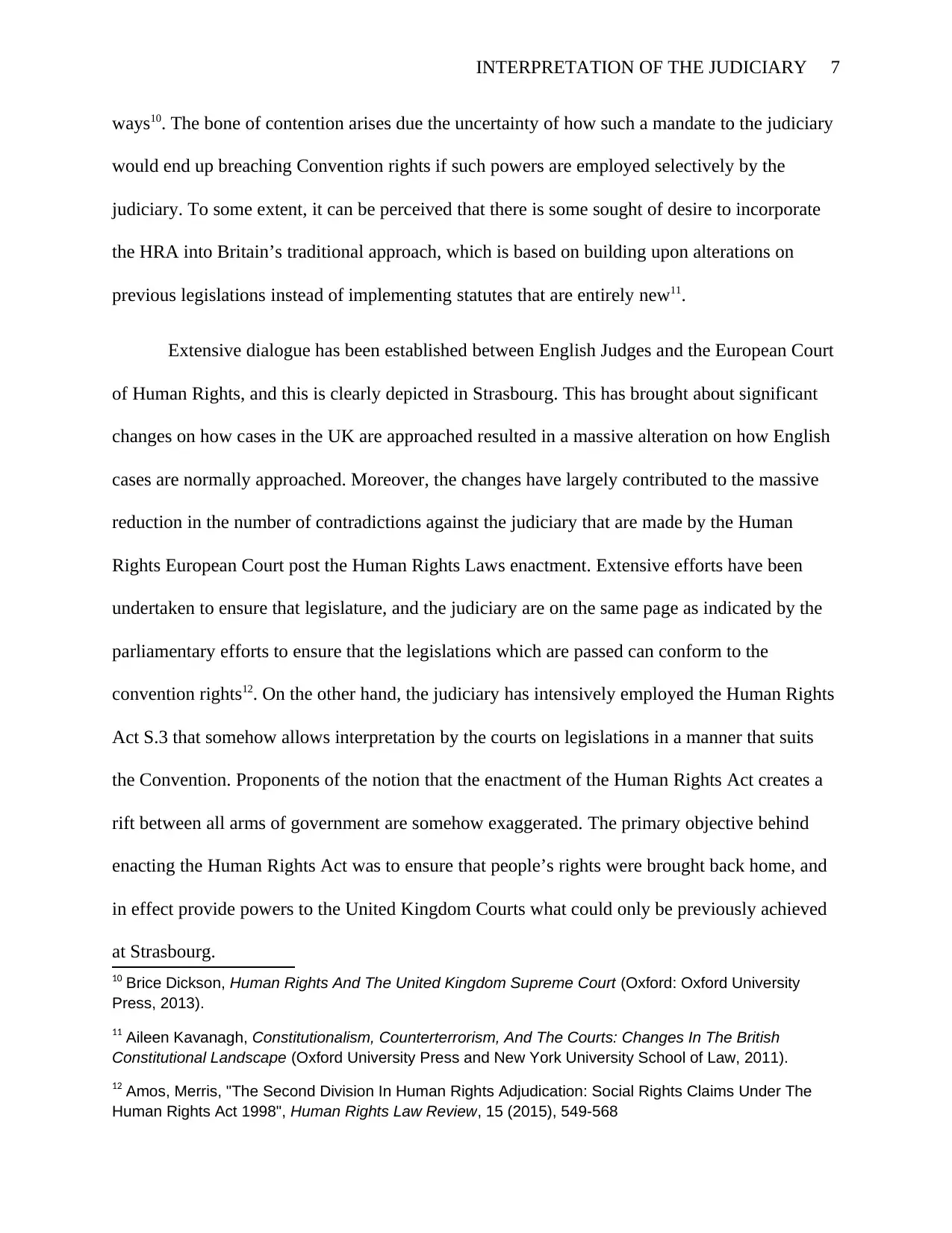
INTERPRETATION OF THE JUDICIARY 7
ways10. The bone of contention arises due the uncertainty of how such a mandate to the judiciary
would end up breaching Convention rights if such powers are employed selectively by the
judiciary. To some extent, it can be perceived that there is some sought of desire to incorporate
the HRA into Britain’s traditional approach, which is based on building upon alterations on
previous legislations instead of implementing statutes that are entirely new11.
Extensive dialogue has been established between English Judges and the European Court
of Human Rights, and this is clearly depicted in Strasbourg. This has brought about significant
changes on how cases in the UK are approached resulted in a massive alteration on how English
cases are normally approached. Moreover, the changes have largely contributed to the massive
reduction in the number of contradictions against the judiciary that are made by the Human
Rights European Court post the Human Rights Laws enactment. Extensive efforts have been
undertaken to ensure that legislature, and the judiciary are on the same page as indicated by the
parliamentary efforts to ensure that the legislations which are passed can conform to the
convention rights12. On the other hand, the judiciary has intensively employed the Human Rights
Act S.3 that somehow allows interpretation by the courts on legislations in a manner that suits
the Convention. Proponents of the notion that the enactment of the Human Rights Act creates a
rift between all arms of government are somehow exaggerated. The primary objective behind
enacting the Human Rights Act was to ensure that people’s rights were brought back home, and
in effect provide powers to the United Kingdom Courts what could only be previously achieved
at Strasbourg.
10 Brice Dickson, Human Rights And The United Kingdom Supreme Court (Oxford: Oxford University
Press, 2013).
11 Aileen Kavanagh, Constitutionalism, Counterterrorism, And The Courts: Changes In The British
Constitutional Landscape (Oxford University Press and New York University School of Law, 2011).
12 Amos, Merris, "The Second Division In Human Rights Adjudication: Social Rights Claims Under The
Human Rights Act 1998", Human Rights Law Review, 15 (2015), 549-568
ways10. The bone of contention arises due the uncertainty of how such a mandate to the judiciary
would end up breaching Convention rights if such powers are employed selectively by the
judiciary. To some extent, it can be perceived that there is some sought of desire to incorporate
the HRA into Britain’s traditional approach, which is based on building upon alterations on
previous legislations instead of implementing statutes that are entirely new11.
Extensive dialogue has been established between English Judges and the European Court
of Human Rights, and this is clearly depicted in Strasbourg. This has brought about significant
changes on how cases in the UK are approached resulted in a massive alteration on how English
cases are normally approached. Moreover, the changes have largely contributed to the massive
reduction in the number of contradictions against the judiciary that are made by the Human
Rights European Court post the Human Rights Laws enactment. Extensive efforts have been
undertaken to ensure that legislature, and the judiciary are on the same page as indicated by the
parliamentary efforts to ensure that the legislations which are passed can conform to the
convention rights12. On the other hand, the judiciary has intensively employed the Human Rights
Act S.3 that somehow allows interpretation by the courts on legislations in a manner that suits
the Convention. Proponents of the notion that the enactment of the Human Rights Act creates a
rift between all arms of government are somehow exaggerated. The primary objective behind
enacting the Human Rights Act was to ensure that people’s rights were brought back home, and
in effect provide powers to the United Kingdom Courts what could only be previously achieved
at Strasbourg.
10 Brice Dickson, Human Rights And The United Kingdom Supreme Court (Oxford: Oxford University
Press, 2013).
11 Aileen Kavanagh, Constitutionalism, Counterterrorism, And The Courts: Changes In The British
Constitutional Landscape (Oxford University Press and New York University School of Law, 2011).
12 Amos, Merris, "The Second Division In Human Rights Adjudication: Social Rights Claims Under The
Human Rights Act 1998", Human Rights Law Review, 15 (2015), 549-568
Paraphrase This Document
Need a fresh take? Get an instant paraphrase of this document with our AI Paraphraser
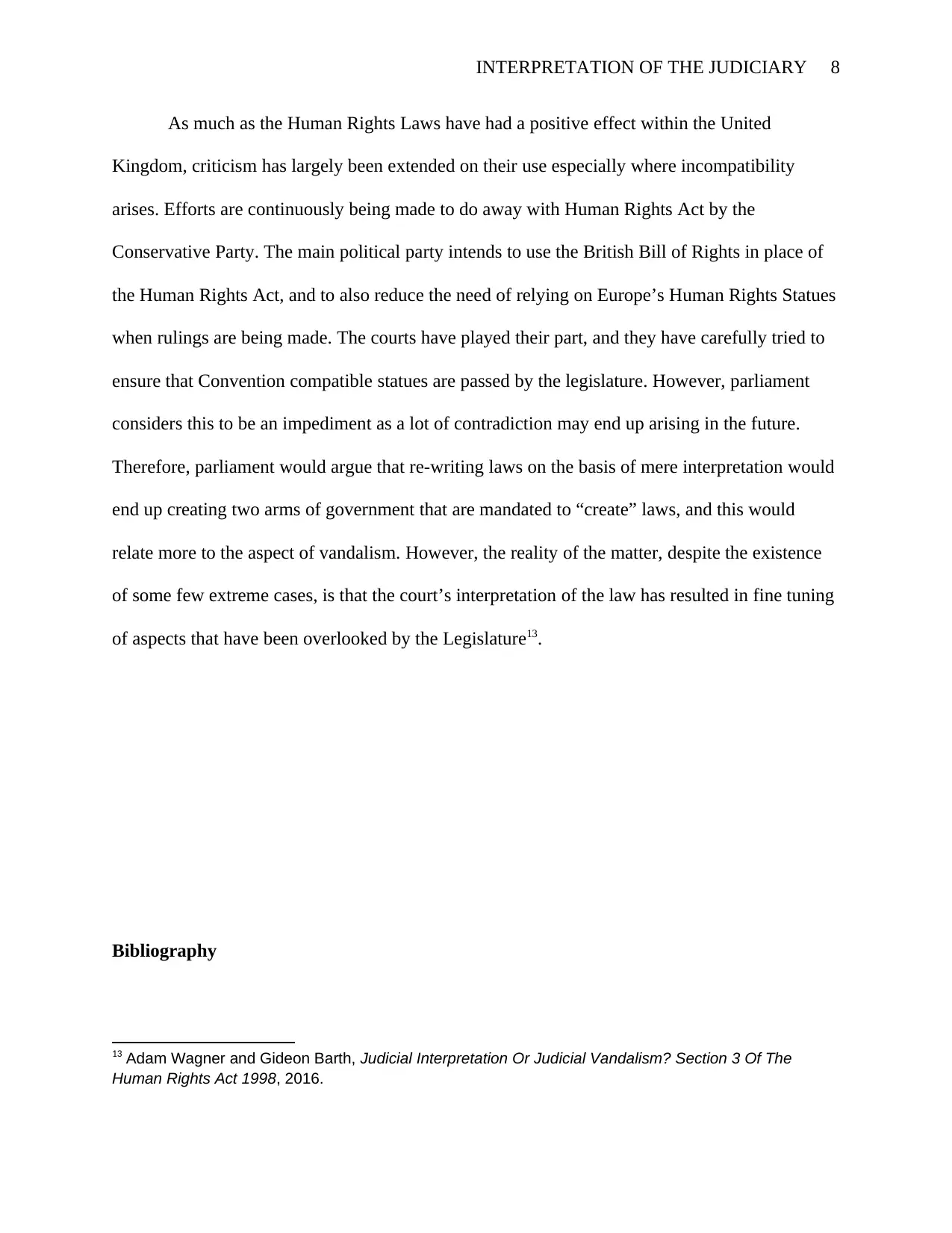
INTERPRETATION OF THE JUDICIARY 8
As much as the Human Rights Laws have had a positive effect within the United
Kingdom, criticism has largely been extended on their use especially where incompatibility
arises. Efforts are continuously being made to do away with Human Rights Act by the
Conservative Party. The main political party intends to use the British Bill of Rights in place of
the Human Rights Act, and to also reduce the need of relying on Europe’s Human Rights Statues
when rulings are being made. The courts have played their part, and they have carefully tried to
ensure that Convention compatible statues are passed by the legislature. However, parliament
considers this to be an impediment as a lot of contradiction may end up arising in the future.
Therefore, parliament would argue that re-writing laws on the basis of mere interpretation would
end up creating two arms of government that are mandated to “create” laws, and this would
relate more to the aspect of vandalism. However, the reality of the matter, despite the existence
of some few extreme cases, is that the court’s interpretation of the law has resulted in fine tuning
of aspects that have been overlooked by the Legislature13.
Bibliography
13 Adam Wagner and Gideon Barth, Judicial Interpretation Or Judicial Vandalism? Section 3 Of The
Human Rights Act 1998, 2016.
As much as the Human Rights Laws have had a positive effect within the United
Kingdom, criticism has largely been extended on their use especially where incompatibility
arises. Efforts are continuously being made to do away with Human Rights Act by the
Conservative Party. The main political party intends to use the British Bill of Rights in place of
the Human Rights Act, and to also reduce the need of relying on Europe’s Human Rights Statues
when rulings are being made. The courts have played their part, and they have carefully tried to
ensure that Convention compatible statues are passed by the legislature. However, parliament
considers this to be an impediment as a lot of contradiction may end up arising in the future.
Therefore, parliament would argue that re-writing laws on the basis of mere interpretation would
end up creating two arms of government that are mandated to “create” laws, and this would
relate more to the aspect of vandalism. However, the reality of the matter, despite the existence
of some few extreme cases, is that the court’s interpretation of the law has resulted in fine tuning
of aspects that have been overlooked by the Legislature13.
Bibliography
13 Adam Wagner and Gideon Barth, Judicial Interpretation Or Judicial Vandalism? Section 3 Of The
Human Rights Act 1998, 2016.
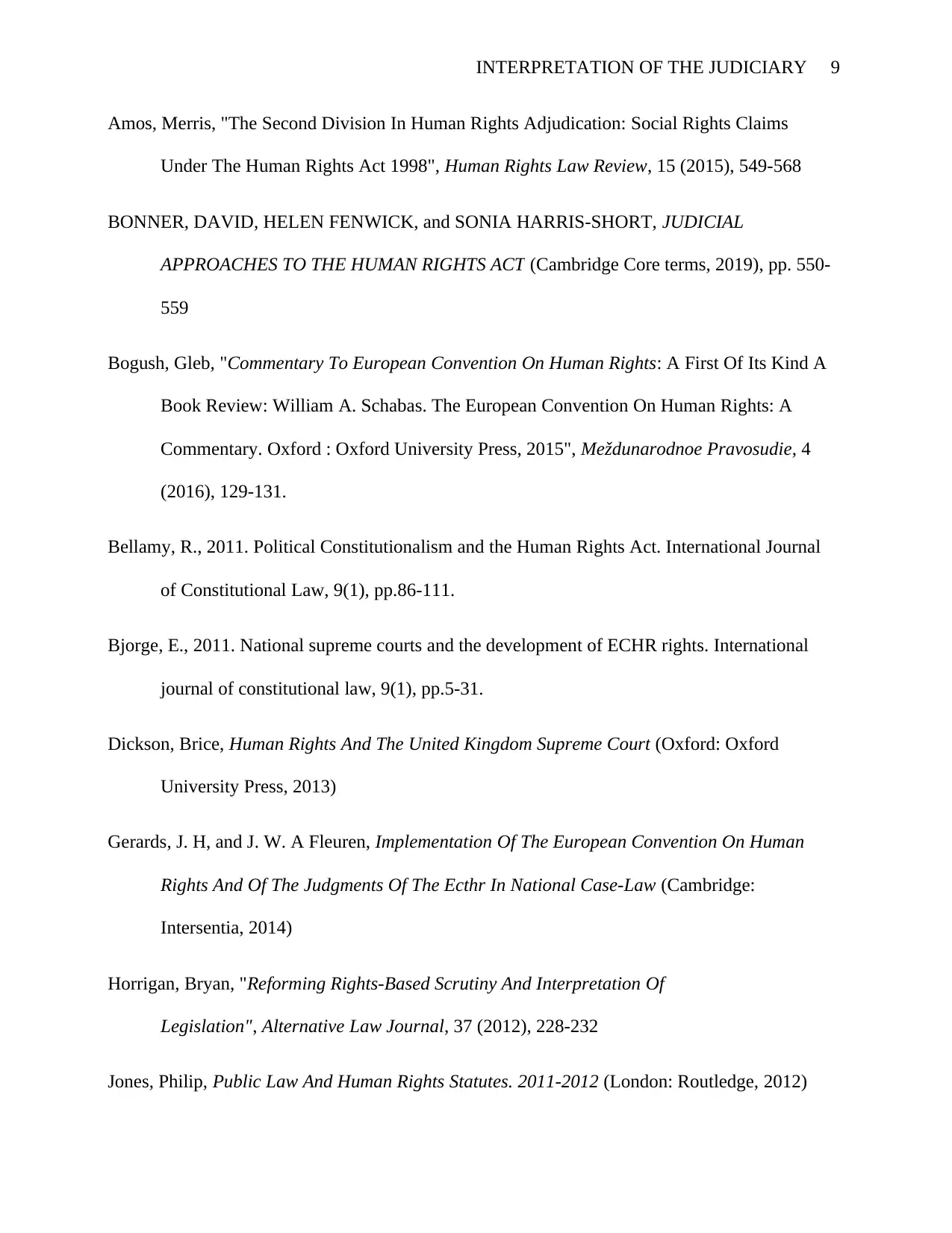
INTERPRETATION OF THE JUDICIARY 9
Amos, Merris, "The Second Division In Human Rights Adjudication: Social Rights Claims
Under The Human Rights Act 1998", Human Rights Law Review, 15 (2015), 549-568
BONNER, DAVID, HELEN FENWICK, and SONIA HARRIS-SHORT, JUDICIAL
APPROACHES TO THE HUMAN RIGHTS ACT (Cambridge Core terms, 2019), pp. 550-
559
Bogush, Gleb, "Commentary To European Convention On Human Rights: A First Of Its Kind A
Book Review: William A. Schabas. The European Convention On Human Rights: A
Commentary. Oxford : Oxford University Press, 2015", Meždunarodnoe Pravosudie, 4
(2016), 129-131.
Bellamy, R., 2011. Political Constitutionalism and the Human Rights Act. International Journal
of Constitutional Law, 9(1), pp.86-111.
Bjorge, E., 2011. National supreme courts and the development of ECHR rights. International
journal of constitutional law, 9(1), pp.5-31.
Dickson, Brice, Human Rights And The United Kingdom Supreme Court (Oxford: Oxford
University Press, 2013)
Gerards, J. H, and J. W. A Fleuren, Implementation Of The European Convention On Human
Rights And Of The Judgments Of The Ecthr In National Case-Law (Cambridge:
Intersentia, 2014)
Horrigan, Bryan, "Reforming Rights-Based Scrutiny And Interpretation Of
Legislation", Alternative Law Journal, 37 (2012), 228-232
Jones, Philip, Public Law And Human Rights Statutes. 2011-2012 (London: Routledge, 2012)
Amos, Merris, "The Second Division In Human Rights Adjudication: Social Rights Claims
Under The Human Rights Act 1998", Human Rights Law Review, 15 (2015), 549-568
BONNER, DAVID, HELEN FENWICK, and SONIA HARRIS-SHORT, JUDICIAL
APPROACHES TO THE HUMAN RIGHTS ACT (Cambridge Core terms, 2019), pp. 550-
559
Bogush, Gleb, "Commentary To European Convention On Human Rights: A First Of Its Kind A
Book Review: William A. Schabas. The European Convention On Human Rights: A
Commentary. Oxford : Oxford University Press, 2015", Meždunarodnoe Pravosudie, 4
(2016), 129-131.
Bellamy, R., 2011. Political Constitutionalism and the Human Rights Act. International Journal
of Constitutional Law, 9(1), pp.86-111.
Bjorge, E., 2011. National supreme courts and the development of ECHR rights. International
journal of constitutional law, 9(1), pp.5-31.
Dickson, Brice, Human Rights And The United Kingdom Supreme Court (Oxford: Oxford
University Press, 2013)
Gerards, J. H, and J. W. A Fleuren, Implementation Of The European Convention On Human
Rights And Of The Judgments Of The Ecthr In National Case-Law (Cambridge:
Intersentia, 2014)
Horrigan, Bryan, "Reforming Rights-Based Scrutiny And Interpretation Of
Legislation", Alternative Law Journal, 37 (2012), 228-232
Jones, Philip, Public Law And Human Rights Statutes. 2011-2012 (London: Routledge, 2012)
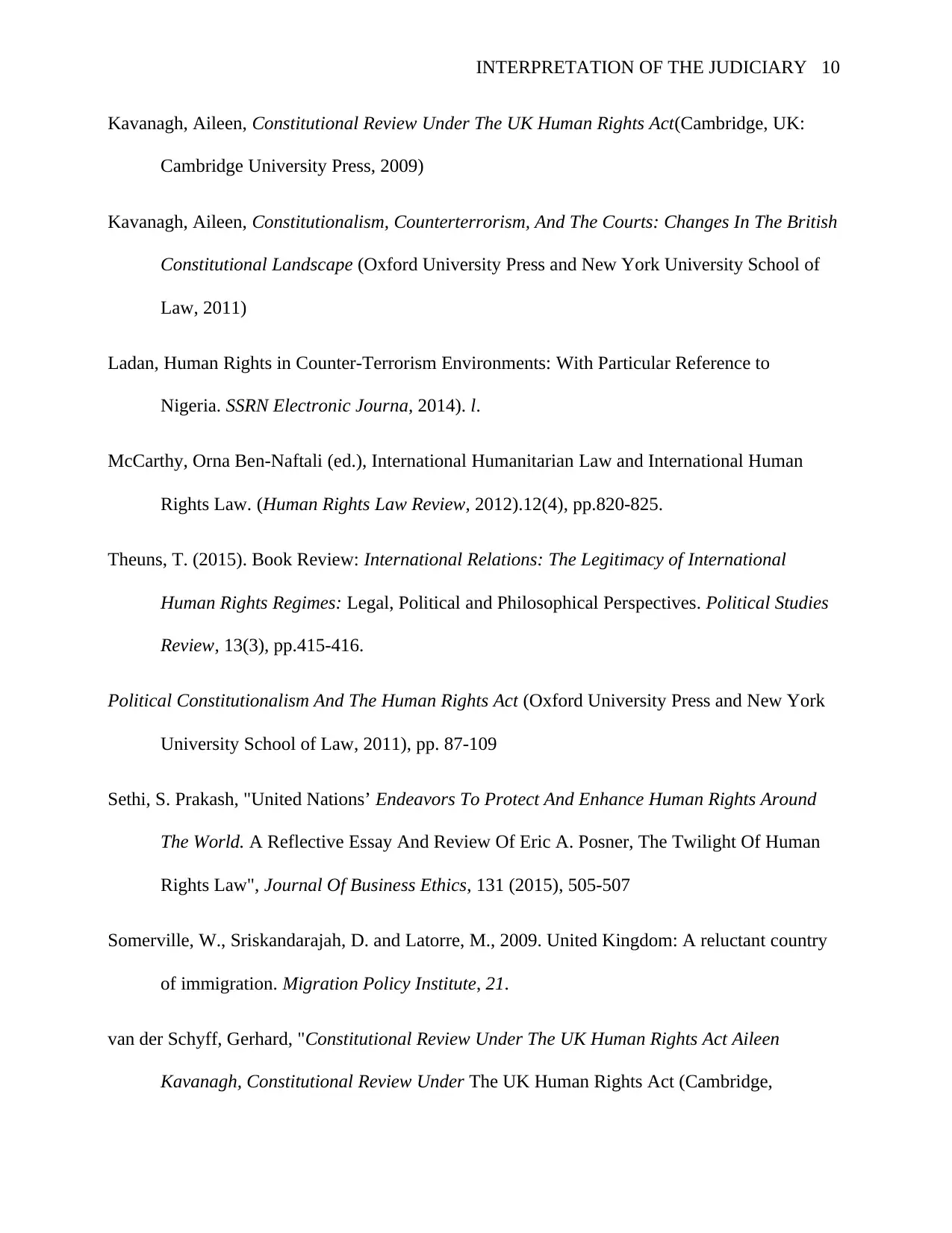
INTERPRETATION OF THE JUDICIARY 10
Kavanagh, Aileen, Constitutional Review Under The UK Human Rights Act(Cambridge, UK:
Cambridge University Press, 2009)
Kavanagh, Aileen, Constitutionalism, Counterterrorism, And The Courts: Changes In The British
Constitutional Landscape (Oxford University Press and New York University School of
Law, 2011)
Ladan, Human Rights in Counter-Terrorism Environments: With Particular Reference to
Nigeria. SSRN Electronic Journa, 2014). l.
McCarthy, Orna Ben-Naftali (ed.), International Humanitarian Law and International Human
Rights Law. (Human Rights Law Review, 2012).12(4), pp.820-825.
Theuns, T. (2015). Book Review: International Relations: The Legitimacy of International
Human Rights Regimes: Legal, Political and Philosophical Perspectives. Political Studies
Review, 13(3), pp.415-416.
Political Constitutionalism And The Human Rights Act (Oxford University Press and New York
University School of Law, 2011), pp. 87-109
Sethi, S. Prakash, "United Nations’ Endeavors To Protect And Enhance Human Rights Around
The World. A Reflective Essay And Review Of Eric A. Posner, The Twilight Of Human
Rights Law", Journal Of Business Ethics, 131 (2015), 505-507
Somerville, W., Sriskandarajah, D. and Latorre, M., 2009. United Kingdom: A reluctant country
of immigration. Migration Policy Institute, 21.
van der Schyff, Gerhard, "Constitutional Review Under The UK Human Rights Act Aileen
Kavanagh, Constitutional Review Under The UK Human Rights Act (Cambridge,
Kavanagh, Aileen, Constitutional Review Under The UK Human Rights Act(Cambridge, UK:
Cambridge University Press, 2009)
Kavanagh, Aileen, Constitutionalism, Counterterrorism, And The Courts: Changes In The British
Constitutional Landscape (Oxford University Press and New York University School of
Law, 2011)
Ladan, Human Rights in Counter-Terrorism Environments: With Particular Reference to
Nigeria. SSRN Electronic Journa, 2014). l.
McCarthy, Orna Ben-Naftali (ed.), International Humanitarian Law and International Human
Rights Law. (Human Rights Law Review, 2012).12(4), pp.820-825.
Theuns, T. (2015). Book Review: International Relations: The Legitimacy of International
Human Rights Regimes: Legal, Political and Philosophical Perspectives. Political Studies
Review, 13(3), pp.415-416.
Political Constitutionalism And The Human Rights Act (Oxford University Press and New York
University School of Law, 2011), pp. 87-109
Sethi, S. Prakash, "United Nations’ Endeavors To Protect And Enhance Human Rights Around
The World. A Reflective Essay And Review Of Eric A. Posner, The Twilight Of Human
Rights Law", Journal Of Business Ethics, 131 (2015), 505-507
Somerville, W., Sriskandarajah, D. and Latorre, M., 2009. United Kingdom: A reluctant country
of immigration. Migration Policy Institute, 21.
van der Schyff, Gerhard, "Constitutional Review Under The UK Human Rights Act Aileen
Kavanagh, Constitutional Review Under The UK Human Rights Act (Cambridge,
Secure Best Marks with AI Grader
Need help grading? Try our AI Grader for instant feedback on your assignments.
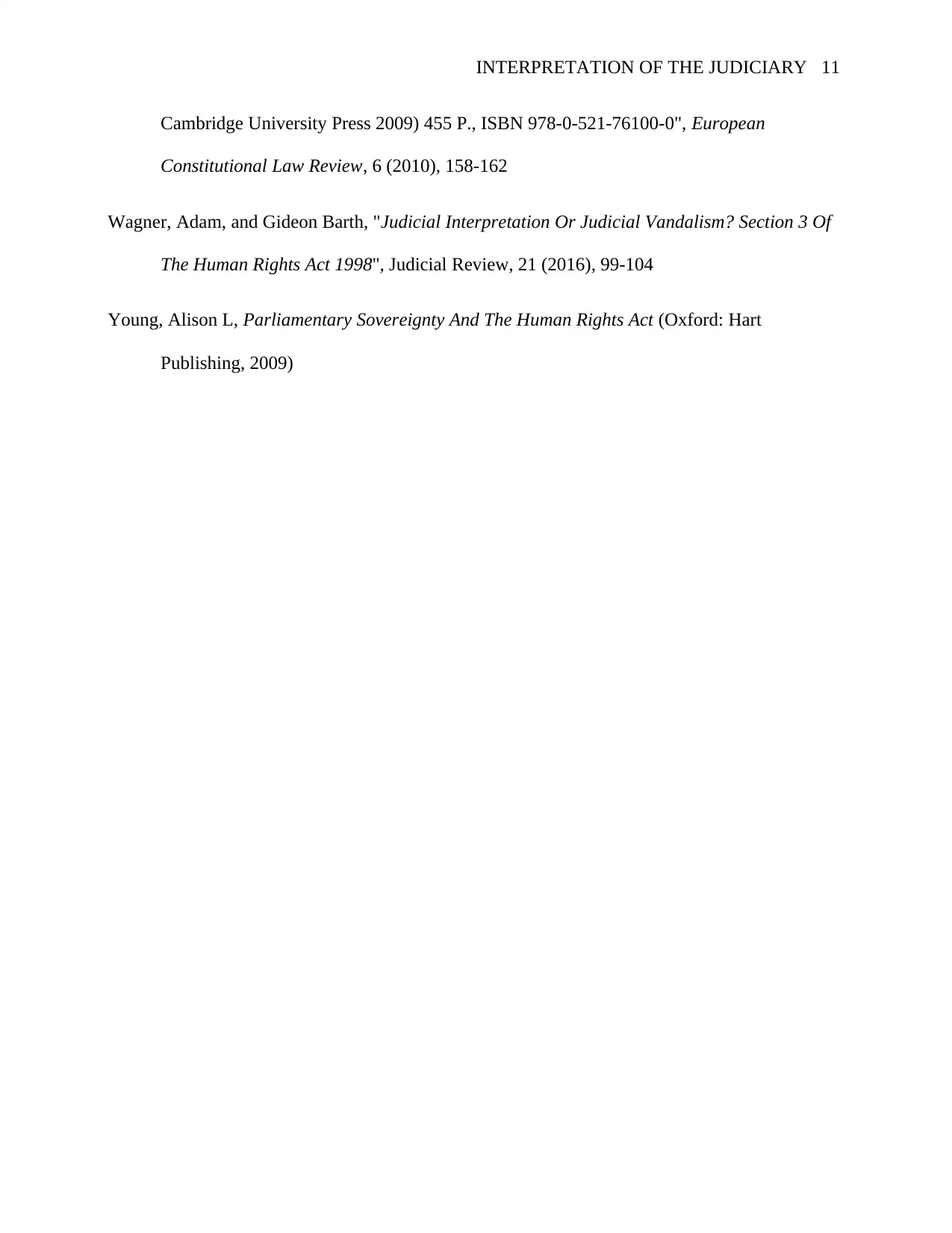
INTERPRETATION OF THE JUDICIARY 11
Cambridge University Press 2009) 455 P., ISBN 978-0-521-76100-0", European
Constitutional Law Review, 6 (2010), 158-162
Wagner, Adam, and Gideon Barth, "Judicial Interpretation Or Judicial Vandalism? Section 3 Of
The Human Rights Act 1998", Judicial Review, 21 (2016), 99-104
Young, Alison L, Parliamentary Sovereignty And The Human Rights Act (Oxford: Hart
Publishing, 2009)
Cambridge University Press 2009) 455 P., ISBN 978-0-521-76100-0", European
Constitutional Law Review, 6 (2010), 158-162
Wagner, Adam, and Gideon Barth, "Judicial Interpretation Or Judicial Vandalism? Section 3 Of
The Human Rights Act 1998", Judicial Review, 21 (2016), 99-104
Young, Alison L, Parliamentary Sovereignty And The Human Rights Act (Oxford: Hart
Publishing, 2009)
1 out of 11
Related Documents
Your All-in-One AI-Powered Toolkit for Academic Success.
+13062052269
info@desklib.com
Available 24*7 on WhatsApp / Email
![[object Object]](/_next/static/media/star-bottom.7253800d.svg)
Unlock your academic potential
© 2024 | Zucol Services PVT LTD | All rights reserved.





